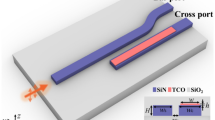Abstract
An off–on switching scheme is introduced which blocks a waveguide path in the passive off-state and transmits the signal in the active on-state. The operating principle is based on the self-diffraction of a narrow guided beam when it escapes from a waveguide with two-dimensional confinement into a region of appropriate length with basically one-dimensional confinement. In particular, a remaining interface of the initial waveguide superimposes reflection, which in sum results in a very efficient asymmetrical blow out of the guided power. In the active on-state, low-loss waveguiding is sustained when an electrode causes an appropriate refractive index change, e.g., due to the thermo-optical effect. Thus, the signal is received in the output waveguide, the identical counterpart of the input guide. The switching behaviour is almost binary with minimal wavelength dependence. This makes the device useful for switching and modulation in a multi-wavelength optical network. For a realistic polymeric waveguide configuration, simulations indicate on-off signal ratios of >30 dB. This satisfies the requirements for crosstalk reduction in switching networks.
Similar content being viewed by others
References
Chen, R. and C. Tsai. IEEE J. Quantum Electron. 23 2205, 1987.
Haruna, M. and J. Koyama. Electron. Lett. 17 842, 1981.
Hida, Y., H. Onose and S. Imamura. Polymer waveguide thermooptic switch with low electric power consumption at 1:3 µm. IEEE Photon. Technol. Lett. 5 782, 1993.
Huang, T., G. Simonis, V. Chinni, P. Wai and C. Menyuk. Opt. Lett. 19 2107, 1994.
Januar, I., R. Feuerstein, A. Mickelson and J. Sauer. J. Lightwave Technol. 10 1202, 1992.
Khan, M., J. Zucker, T. Chang, N. Sauer and M. Divino. IEEE Photon. Technol. Lett. 6 394, 1994.
Lin, S., W. Feng, J. Powelson, R. Feuerstein, L. Bintz, D. Tomic and A. Mickelson. J. Lightwave Technology 14 2012, 1996.
Murphy, E., T. Murphy, R. Irvin, R. Grencavich, G. Davis and G. Richards. Proc. ECIO, paper EFD5, 1997.
Pennings, E., G.-D. Khoe, M. Smit and T. Staring. IEEE J. Select. Topics Quantum Electron. 2 151, 1996.
Silberberg, Y., P. Perlmutter and J. Baran. Appl. Phys. Lett. 51 1230, 1987.
Soldano, L. and E. Pennings. J. Lightwave Technol. 13 615, 1995.
Takizawa, K. Opt. Lett. 11 818, 1986.
Thurston, R., E. Kapon and Y. Silberberg. Proc. SPIE 836 211, 1987.
Author information
Authors and Affiliations
Rights and permissions
About this article
Cite this article
Pertsch, T., Wächter, C. Asymmetrical off–on switches for crosstalk reduction in switching networks. Optical and Quantum Electronics 31, 957–963 (1999). https://doi.org/10.1023/A:1006988008605
Issue Date:
DOI: https://doi.org/10.1023/A:1006988008605




